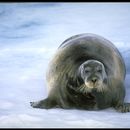Diagnostic Description
provided by FAO species catalogs
Bearded seals are large, but look even longer because of their small head and relatively short foreflippers. The head is rounded and somewhat narrow, and the eyes are relatively small and close-set. The muzzle is wide and fleshy, with widely spaced nostrils. The abundant vibrissae are pale, not beaded as in other Arctic phocids, and are long and densely packed. When wet they are straight, but when dry they curl inwards at the tips. The whiskers are sufficiently conspicuous to have given rise to the common name, "bearded" seal. The foreflippers are short, relatively broad, and strong, with robust claws. Unlike any other phocid, the bearded seal's foreflippers end in digits of about the same length, though the middle digits may be slightly longer on some individuals. This creates a square, or slightly rounded, end to the flippers. Unlike all other Arctic phocids, bearded seals have 4 retractable teats, instead of 2. Adults are slightly darker above than below. Body coloration varies considerably from light or dark grey to brown: the face and flippers are often rust-coloured. Pups have a long, dark, wavy coat, with up to 4 transverse bands of lighter colour from the back to the crown of the head. The muzzle and the area around the eyes are pale. Sometimes a dark line, originating at the crown, extends between the eyes. The dental formula is I 3/2, C 1/1, PC 5/5. Can be confused with: Bearded seals share their range with 7 other phocids: harbour seal, Larga seal, ringed seal, ribbon seal, harp seal, hooded seal and grey seal. Of these, most are smaller, spotted (or otherwise uniquely coloured), or generally distributed further south. In the North Atlantic, the bearded seal is most likely to be mistaken for the hooded seal on shore, and additonally the harp seal in the water. These latter species have distinctively marked colour patterns, not likely to be confused with the more-or-less uniform pattern of bearded seals.
- bibliographic citation
- Marine mammals of the world. Jefferson, T.A., S. Leatherwood & M.A. Webber - 1993. FAO species identification guide. Rome, FAO. 320 p. 587 figs. .
- author
- Food and Agriculture Organization of the UN
Size
provided by FAO species catalogs
Adults range up to 2.5 m in length. Adult females are slightly longer than males. In the Bering Sea, males reach 262 kg and females 361 kg. Pups are, on average, about 1.31 m and 33.6 kg at birth.
- bibliographic citation
- Marine mammals of the world. Jefferson, T.A., S. Leatherwood & M.A. Webber - 1993. FAO species identification guide. Rome, FAO. 320 p. 587 figs. .
- author
- Food and Agriculture Organization of the UN
Brief Summary
provided by FAO species catalogs
Pups are born in the open on pack ice, from mid-March to early May. After the breeding season, many seals migrate northward with the retreating ice, returning southward again as the ice advances in autumn and winter. Bearded seals are solitary. Seals rarely haul out on the same ice floe with other seals, and even then, maintain healthy distances from neighbors. At times, however, currents cause ice pile-ups in small areas, forcing aggregation of seals. Bearded seals are exceptionally wary and always haul out with their head very close to the water at an ice edge or breathing hole. In the water, bearded seals are often found "bottling" vertically, asleep. When startled, they swim with strong strokes of the foreflippers. Foreflippers are probably also important in social interactions.Bearded seals feed on many species of small invertebrates that live on, and in, the bottom. It is likely that they supplement their diet with fishes, as well.
- bibliographic citation
- Marine mammals of the world. Jefferson, T.A., S. Leatherwood & M.A. Webber - 1993. FAO species identification guide. Rome, FAO. 320 p. 587 figs. .
- author
- Food and Agriculture Organization of the UN
Benefits
provided by FAO species catalogs
Bearded seals have been, and continue to be, hunted by humans. Subsistence hunting goes back to prehistoric times, and they are still a mainstay of many local villages in the far north. They are a source of food, but also provide valuable hides for clothing and covering boats. Small-scale commercial harvesting is engaged in by the Russians to this day. IUCN: Insufficiently known.
- bibliographic citation
- Marine mammals of the world. Jefferson, T.A., S. Leatherwood & M.A. Webber - 1993. FAO species identification guide. Rome, FAO. 320 p. 587 figs. .
- author
- Food and Agriculture Organization of the UN

